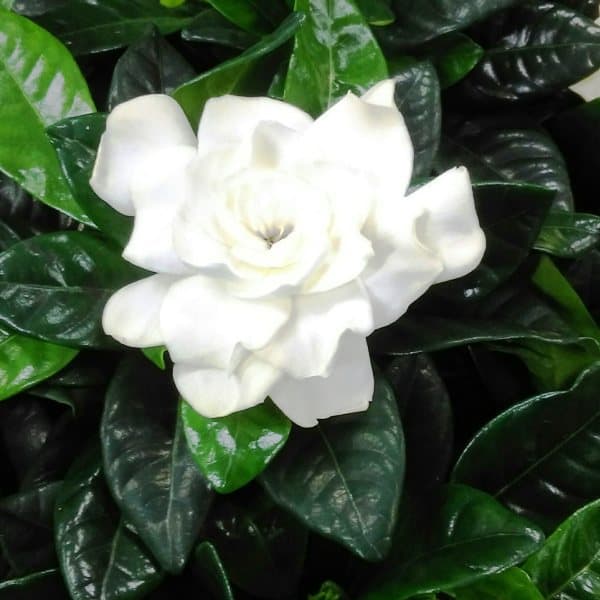Last updated on January 26th, 2022
Our site is reader supported, this means we may earn a small commission from Amazon and other affiliates when you buy through links on our site.
More commonly known as the Cape Jasmine, it is probably one of the most beautiful and highly scented houseplants available for the home. This plant is also known for being difficult to grow but with a little care and advice, this does not have to be the case. You can soon reap the benefit of these beautiful shrubs with their glossy green leaves and creamy white flowers that last for months in a row.
Although in the UK these plants are more commonly grown as houseplants, they can be grown outdoors in sheltered positions in areas where the weather may be milder in winter. There are also a few newer and exciting varieties such as Gardenia jasminoides ‘Crown Jewel’ and Gardenia jasminoides ‘Kleim’s Hardy’ (available from Amazon.co.uk – here) which are hardier and can be grown outdoors.

Gardenia Care
Growing indoors
Gardenia needs to be grown in quality ericaceous compost as they are hungry, acid-loving plants and the soil needs to be kept moist, but not too wet because this can damage the plant and cause the leaves to yellow. They grow best when grown in a bright position, for example, on a sunny windowsill, but not in direct light as this can cause leaf scorch and the plants will begin to wilt.
Try to keep the plants within a temperature between of 15–18°C (59–65°F) at night and 21-24°C (70-75°F) during spring and summer when it is actively growing. In winter, temperatures of 10–15 °C (50–59 °F) or slightly warmer are fine.
These sweetly-scented, white flowering plants usually flower in spring and last into the summer depending on the variety. Remove any faded flowers and prune out any dead or damaged growth, remove any branches to keep a formal shape after flowering.
Growing Gardenia outdoors
With the introduction of Gardenia jasminoides ‘Crown Jewel’ and Gardenia jasminoides ‘Kleim’s Hardy’ these varieties are hardier and can be grown outdoors, however, may require winter protection. Both of these beautiful varieties grow to approximately 80cm tall and can be planted in a sheltered position, in dappled shade where they are protected from direct sunlight. They need to be grown in acidic soil and kept moist, mulch around the base of plants and cover with fleece in winter to help protect the plants from frost. You can even buy fleece jackets designed for this very job.
If growing outdoors, you may be better growing in pots where they can be moved to more sheltered positions for the winter, such as a cold greenhouse or conservatory.
Watering
The key here is to keep the soil moist but not too wet, especially during the summer before allowing the soil to dry again slightly in winter before each water interval. This is the case for Gardenia whether they are grown indoors or outdoors.
If grown indoors they are best grown with their pot sitting on the top of some pebbles or decorative stones in a tray filled with water. This helps with humidity and it is also worth spraying with water every few days to mist the plant.
Feeding
Gardenia are very hungry plants and feeding them is essential for healthy plants to thrive and reward you with their distinctive creamy-white scented flowers. In spring, when the plants start to actively grow, feed with a high in nitrogen liquid feed and continue doing this weekly until the end of summer.
Taking cuttings
Unlike growing Gardenia, it is actually very easy to take cuttings and they are usually very successful and easy to root. Simply take a softwood cutting in spring or a semi-hardwood cutting in summer and grow on in single pots before potting them on as they become pot bound. Within a couple of years, you will be rewarded with nice, established, bushy plants which is ideal because Gardenia appears to be short-lived and soon become less fruitful.

Common Gardenia problems
Most problems associated with Gardenia are usually caused by incorrect watering, temperature, exposure to direct sunlight or too much shade. Below are the most common problems and how to try and avoid them
- Leaves turning yellow before dropping – The main reason for this is usually too much water, try to keep the soil moist but not too wet. If the correct watering method has been used then try applying sequestered iron. This available from Amazon.co.uk here and it can also be purchased from nurseries or online.
- Leaves turning brown around the edges and tips of leaves – This is a dead giveaway that it is not getting enough water and the soil is probably being allowed to become too dry before watering. Plants in the garden also need watering regularly.
- Leaves wilting when the soil is still moist – This is usually caused because the plant is in an area that is too warm and it is losing water through it’s leaves faster than the roots can replace it. Move to a shadier spot and mist the leaves daily. Never mist over flowers.
- No flower buds or flowers – This could be caused (in houseplant varieties) by the temperature being too warm at night. Try to keep temperature below 18°C (65°F) if possible.
- Buds falling off the plant – This is a common problem seen with Gardenias and is usually caused by one of two reasons or a combination of both. First reason, incorrect watering by either not enough water or too much. The second reason is inconsistent temperatures, try to place in a position where the temperature will stay quite consistent ideally at 21-24°C (70-75°F) during the day and slightly cooler at night.


